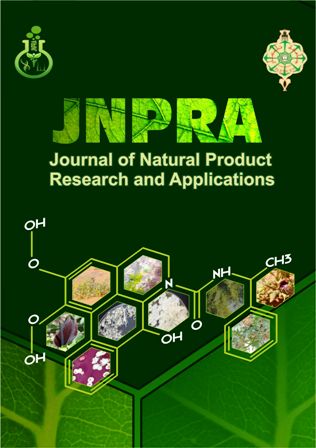Phytochemical study and evaluation of α-Amylase inhibitory effect of extracts from Cistanche violacea Desf.
DOI:
https://doi.org/10.46325/jnpra.v3i02.62Keywords:
Diabetes mellitus, Cistanche violacea, α-amylase, phenolic compounds, inhibitory effect.Abstract
Cistanche violacea Desf. is a species of the family Orobanchaceae. It is an angiosperm dicotyledonous holoparasitic plant, which lacks chlorophyll. This work focuses on the search for an inhibitory effect of the enzymatic activity of α-amylase, in the presence of the crude water-methanol extract, of the underground part of C. violacea, prepared by maceration or decoction and its ethyl acetate fractions. Qualitative phytochemical tests and quantitative assays of phenolic compounds of the prepared extracts were performed. The effect of each extract on the activity of the α-amylase enzyme was evaluated under optimal conditions (pH 6.9 and T° 37°C). The results of phytochemical tests revealed the presence of tannins, flavonoids, free quinones, terpenoids and reducing compounds. The determination of phenolic compounds showed that the ethyl acetate extract prepared by maceration was the richest in total polyphenols and flavonoids with contents of the order of 82.937±6.750μg EqGA/mg D.W and 112.345±25.719μg EqC/mg D.W respectively. While the crude hydromethanolic extract prepared by maceration presented the highest content of condensed tannins (525.5±77.5μg EqC/mg D.W). On the other hand, the ethyl acetate extract prepared by decoction of the underground part of C. violacea showed a better inhibitory activity of the α-amylase enzyme, with IC50 value of 1.88 mg/ml, compared to the other extracts tested. This activity remains low compared to acarbose (IC50 = 0.132 mg/ml). We concluded that the roots of C. violacea exerts an inhibitory effect on α-amylase activity and thus on the regulation of hyperglycemia through a decrease in intestinal glucose absorption
References
Abbou, F., Azzi, R., Ouffai, K., El Haci, I. A., Belyagoubi-Benhammou, N., Bensouici. C., Benamar, H. (2022). Phenolic profile, antioxidant and enzyme inhibitory properties of phenolic-rich fractions from the aerial parts of Mentha pulegium L. South African Journal of Botany , 146, 196-204. doi: 10.1016/j.sajb.2021.10.024.
Alia, F., Chouikh, A., Djahra, A. B., Bousbia Brahim, A., Nani, S., & Tliba, A. (2021). Comparative study of some physiocochemical and biological properties of effect host species variation on the relationship Saharan parasitic plant Cistanche violacea (Desf.) Beck. Notulae Scientia Biologicae,13(4), 1-2. doi: 10.15835/nsb13411054.
Ben Attia, I., Zucca, P., Marincola, F. C., Nieddu, M., Piras, A., Rosa, A., et al., (2020). Evaluation of the Antioxidant and Cytotoxic Activities on Cancer Cell Line of Extracts of Parasitic Plants Harvested in Tunisia.. Polish Journal of Food Nutrition Sciences, 70 (3), 253-263. doi.org/10.31883/pjfns/122040.
Ben Lacheheb, A., and Houamed, M. (2019). Contribution to a study of the phytochemical and antioxidant activity of the desert parasitic plant Cistanche violacea (Dest.) Berk. Master's thesis, El Ouadi University.
Bouchouka, E. (2016). Extraction of polyphenols and study of antioxidant and antibacterial activities of some Saharan plants. Thesis, Univ. BADJ Mokhtar-Annaba.
Chenghuel, A. (2019). Phytochemical study and biological activity of different extract from flowers of parasitic plant Cistanche tinctoria (Desf.) Berk. Mémoire de master université El-Oued.
Etxeberria, U., Garza, A., Campion, J., Martinez, J. A., & Milagr F. (2012). Antidiabetic effects of natural plant extracts via inhibition of carbohydrate hydrolysis enzymes with emphasis on pancreatic α amylase. Expert Opinion on Therapeutic Targets, 16(3), 269-271. doi: 10.1517/14728222.2012.664134.
Hoang Anh, L. H., Xuan, T. D., Dieu Thuy, N. T. D., Quan, N. V., & Trang, L. T. (2020). Antioxidant and α-amylase Inhibitory Activities and Phytocompounds of Clausena indica Fruits. Medicines, 7(3): 10. doi.org/10.3390/medicines7030010.
Kacimi, A., and Amman Nouas, S. (2020). Estimation of phenolic content and antioxidant activity of a crude extract from a Cistanche violacea (Desf.) Beck plant. Academic Master's Thesis. Hamma Lakhder El-Ouadi University.
Mahdi, S., Azzi, R., & Lahfa, F. B. (2020). Evaluation of in vitro α-amylase and α-glucosidase inhibitory potential and hemolytic effect of phenolic enriched fractions of the aerial part of Salvia officinalis L. Diabetes & Metabolic Syndrome: Clinical Research & Reviews, 14(4): 689-694. doi: 10.1016/j.dsx.2020.05.002.
Ponnusamy, S., Haldar, S., Mulani, F., Zinjarde, S., Thulasiram, H., & Ravi-Kumar, A. (2015). Gedunin and Azadiradione: Human Pancreatic Alpha-Amylase Inhibiting Limonoids from Neem (Azadirachta indica) as Anti-Diabetic Agents. PLOS One, 10(10), 1 – 19. doi: 10.1371/journal.pone.0140113.
Rhabasa-Lhoret R., Chiasson J.L. (2004). International Textbook of Diabetes Mellitus, vol. 1, third ed. John Wiley & Sons Ltd., UK. P 901–914.
Sales, P. M., Souza, P. M., Simeoni, L. A., Magalhães, P. O., & Silveira, D. (2012). α-Amylase Inhibitors: A Review of Raw Material and Isolated Compounds from Plant Source. Journal of Pharmacy & Pharmaceutical Sciences, 15(1), 141 – 142. doi: 10.18433/j35s3k.
Soni, L. K., Dobhal, M. P., Arya, D., Bhagour, K., Parasher, P., & Gupta, R. S. (2018). In vitro and in vivo antidiabetic activity of isolated fraction of Prosopis cineraria against streptozotocin-induced experimental diabetes: A mechanistic study. Biomedicine & Pharmacotherapy, 108: 1015–1021. doi: 10.1016/j.biopha.2018.09.099.
Sun, B., Ricardo-da-Silva, J. M. & Spranger, I. (1998). Critical factors of vanillin assay for Catechins and Proanthocyanidins. Journal Agricultural and Food Chemistry, 46: 4267-4274. doi.org/10.1021/jf980366j.
Sun, L., Warren, F. J., & Gidley, M. J. (2019). Natural products for glycaemic control: Polyphenols as inhibitors of α-amylase. Trends in Food Science and Technology, 91, 262–273. doi.org/10.1016/j.tifs.2019.07.009.
Vermerius, W., & Nicholson, R., 2006. Isolation and Identification of Phenolic Compounds. In: Phenolic Compound Biochemistry. Springer, Dordrecht, p. 35-191.
WHO : World Health Organization. Diabète sucré. 2002. Aide mémoire. ; N°138.
Worthington C. C. (1988). Worthington enzyme manual: enzymes and related biochemicals. Worthington Biochemical Corporation.
Zhishen, J., Mengcheng, T., & Jianming, W. (1999). The determination of flavonoid contents in mulberry and their scavenging effects on superoxide radicals. Food Chemistry., 64, 555-559. doi.org/10.1016/S0308-8146(98)00102-2.
Downloads
Published
Issue
Section
License

This work is licensed under a Creative Commons Attribution-NonCommercial 4.0 International License.






